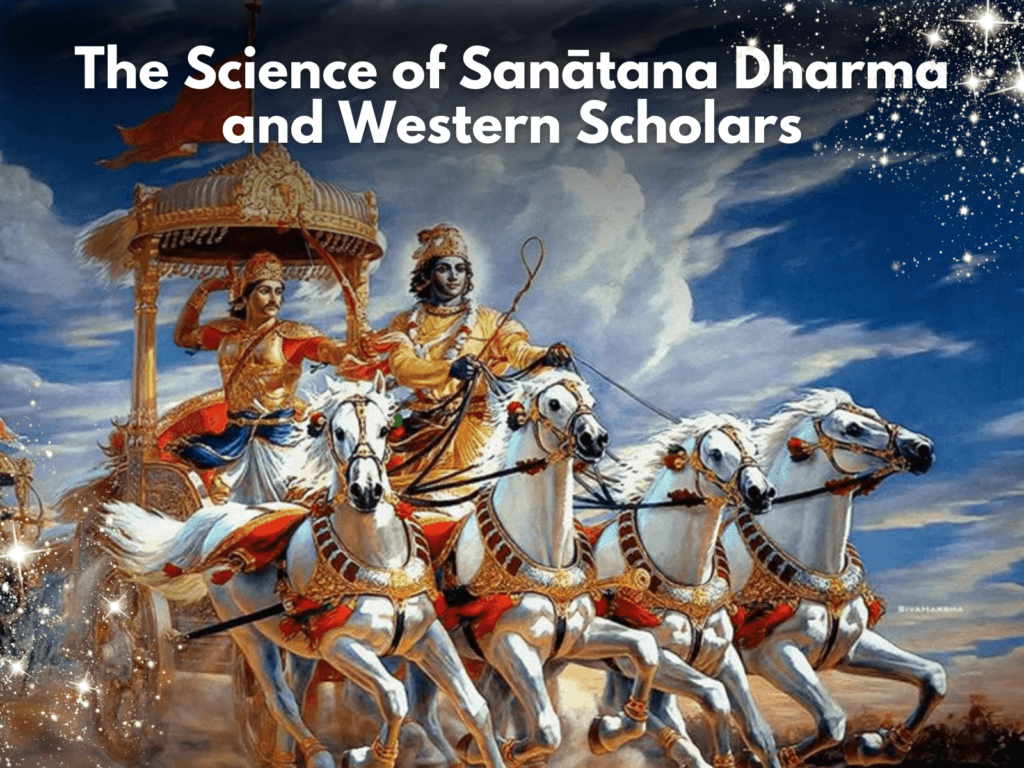
The Science of Sanātana Dharma and Western Scholars
April 17, 2025
The Science of Sanātana Dharma and Western Scholars
Sanātana Dharma, often referred to as the eternal way of life, is a profound synthesis of spirituality, philosophy, and science. Unlike conventional religions, it is not merely a set of beliefs but an ever-evolving system rooted in deep scientific inquiry and experiential wisdom. Today, as modern science advances, scholars and philosophers are increasingly recognizing the scientific essence embedded in the Vedic traditions of Bharat.
Sanātana Dharma: The Eternal Science of Life
“यो वै भूमा तत्सुखं, नाल्पे सुखमस्ति।” (Chandogya Upanishad 7.23.1)
“That which is infinite is bliss; there is no happiness in the finite.”
Sanātana Dharma is not confined to mere rituals or idol worship but is an all-encompassing philosophy that embraces both the seen and unseen aspects of existence. It has coexisted with scientific pursuits for millennia, providing insights into cosmology, medicine, and human consciousness.
In contrast, the term Hindutva, coined by Vinayak Damodar Savarkar in 1929, was an ideological construct aimed at forging a collective identity. However, true Sanātana Dharma transcends such classifications, focusing instead on universal wisdom and human evolution.
Swami Vivekananda’s Vision: The Fusion of Science and Spirituality
“शिवज्ञानं जीवसेवा।”
“Service to humanity is the highest realization of Shiva.”
Swami Vivekananda, a luminary of Sanātana Dharma, saw no contradiction between science and spirituality. His teachings emphasized the practical application of dharma, urging people to transcend mere rituals and engage in service to mankind.
His journey across Bharat (1888–1893) opened his eyes to the struggles of the masses. After meditating for three days in Kanyakumari, he resolved to uplift the nation through knowledge, education, and self-empowerment. The foundation of the Ramakrishna Mission (1897) was an extension of this vision—integrating Vedantic wisdom with humanitarian service.
Unlike many religious leaders, Swami Vivekananda’s focus was not on blind faith but on the scientific approach to spirituality, emphasizing self-inquiry, yoga, and rational thought as means to divine realization.
The Scientific Foundations of Sanātana Dharma
“सर्वं खल्विदं ब्रह्म।” (Chandogya Upanishad 3.14.1)
“All that exists is but Brahman.”
Sanātana Dharma is based on profound scientific principles, many of which modern research is only now beginning to validate. Below are some examples:
Wearing a Toe Ring (Metallotherapy)
Scientific Basis:
- Toe rings exert pressure on a nerve connected to the uterus, regulating the menstrual cycle.
- Silver, a conductor of energy, absorbs electromagnetic vibrations from the earth and transfers them to the body.
Throwing Coins in Rivers (Water Purification)
Scientific Basis:
- In ancient times, coins were made of copper, an essential metal with antimicrobial properties.
- Dropping them in water helped purify drinking sources, a natural method of water purification.
Joining Hands in Namaskāra (Acupressure Therapy)
Scientific Basis:
- Pressing fingertips activates acupressure points linked to the eyes, ears, and mind.
- Enhances memory and promotes alertness.
Applying Tilak/Kumkum (Energy Conservation)
Scientific Basis:
- The center of the forehead (Ajna Chakra) is a vital energy point.
- Applying Tilak prevents energy dissipation, enhancing concentration.
Charan Sparsh (Touching Feet) and Energy Circulation
Scientific Basis:
- Creates an energy circuit between the giver and receiver, transferring positive vibrations.
- Enhances humility and respect, strengthening social bonds.
Worshipping Tulsi (Ayurvedic Significance)
Scientific Basis:
- Tulsi (Holy Basil) has potent antimicrobial, anti-inflammatory, and immunity-boosting properties.
- Reduces stress and purifies air, making it vital for holistic well-being.
Temple Architecture and Energy Fields
Scientific Basis:
- Ancient temples were built on geomagnetic energy spots to harness earth’s vibrations.
- Walking around the Garbhagriha (sanctum) absorbs these positive energies, enhancing well-being.
Sitting on the Floor While Eating (Postural Benefits)
Scientific Basis:
- Sukhasana (cross-legged position) aids digestion by optimizing blood flow to the stomach.
- Prevents overeating and ensures mindfulness in consumption.
Mehendi Application (Cooling Therapy)
Scientific Basis:
- Natural cooling properties help reduce stress and anxiety, calming the nervous system.
- Particularly beneficial for brides to relieve pre-wedding stress.
Temple Bells and Sound Therapy
Scientific Basis:
- The frequency of temple bells resonates with the brain’s hemispheres, enhancing concentration.
- Clears negative energies and promotes a meditative state.
Sanātana Dharma: The Universal Science of Life
“धर्म एव हतो हन्ति, धर्मो रक्षति रक्षितः।” (Manusmriti 8.15)
“Dharma, when upheld, protects; when destroyed, it leads to destruction.”
Sanātana Dharma is not a mere belief system but a living tradition based on scientific principles. Every ritual, custom, and practice is designed to enhance well-being—physical, mental, and spiritual. Modern science is slowly uncovering what the rishis of ancient Bharat knew through deep meditation and observation.
Even in cosmology, Vedic texts described concepts such as:
- Spherical Earth: “भुगोलं पृथिवी रूपं” (Surya Siddhanta)
- Heliocentrism: “सूर्य आत्मा जगतस्तस्थुषश्च” (Rigveda 1.115.1)
- Time Dilation: The concept of different time scales in different realms (yugas).
Conclusion: Science and Spirituality—Two Sides of the Same Coin
Swami Vivekananda once said:
“धर्म का आधार मानवता है, और मानवता का आधार धर्म।”
“The foundation of Dharma is humanity, and the foundation of humanity is Dharma.”
The scientific roots of Sanātana Dharma make it not just a faith but an experiential science—a holistic system that integrates material and spiritual life. Unlike rigid doctrines, it evolves with knowledge, encouraging both devotion (bhakti) and rational inquiry (jnana).
As Western scholars explore this profound wisdom, the world is beginning to recognize that Sanātana Dharma is not just ancient—it is timeless.
